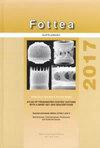贵州喀斯特地貌中的三个陆生无柄藻新种
IF 1.4
3区 生物学
Q3 PLANT SCIENCES
引用次数: 12
摘要
在光镜和扫描电镜观察的基础上,对中国中南部喀斯特地貌中的三种新的陆生植物Achnanthidium进行了研究和描述,并与世界上类似的分类群进行了比较。a . mediolanceolatum sp. nov.是椭圆形披针形的,而不是在这个属中更典型的线状披针形,以及在raphe瓣上有一个蝴蝶结形的中心区域和在raphe瓣上有一个大的披针形轴向区域,这些特征一起使这个物种很容易与其他物种区分开来。小叶蝉(A. parvulum sp.)和贵州叶蝉(A. guizhouensis sp. 11 .)呈线形-椭圆型,以蜘蛛蛛(Achnanthidium)多见,与其他种的差异主要表现在大小、缝型、条纹密度和中部形状等方面。我们将这三个新种与形态相似的分类群进行了比较,并介绍了它们的生态环境和分布。本文讨论了Achnanthidium和Psammothidium的关系,并从贵州这些新种的资料来看,这两个属难以区分。本文章由计算机程序翻译,如有差异,请以英文原文为准。
Three new subaerial Achnanthidium (Bacillariophyta) species from a karst landform in the Guizhou Province, China
Three new subaerial species of Achnanthidium are examined and described from a karst landform of central-south China based on light and scanning electron microscopy observations, and are compared with similar taxa worldwide. A. mediolanceolatum sp. nov. is elliptical-lanceolate, not linear-lanceolate as is more typical in this genus, as well as having a bow-tie shaped central area on the raphe valve and a large lanceolate axial area on the rapheless valve, features which together make it easy to distinguish this species from others. A. parvulum sp. nov. and A. guizhouensis sp. nov. are linear-elliptical in shape, which is more common for Achnanthidium and they differ from other species mainly in size, raphe, density of striae and shape of the central area. We compared these three new species with morphologically-similar taxa, and present their ecological settings and distributions as well. The relationship between Achnanthidium and Psammothidium is discussed, and the data from these new species from Guizhou presented herein suggest the two genera are difficult to separate.
求助全文
通过发布文献求助,成功后即可免费获取论文全文。
去求助
来源期刊

Fottea
生物-植物科学
CiteScore
4.00
自引率
9.10%
发文量
20
审稿时长
>12 weeks
期刊介绍:
Fottea is a journal of Czech Phycological Society (formerly bulletin Czech Phycology). Fottea publishes papers on all aspects of the ecology, physiology, biochemistry, cell biology, molecular biology, systematics and uses of algae (including cyanobacteria)
 求助内容:
求助内容: 应助结果提醒方式:
应助结果提醒方式:


